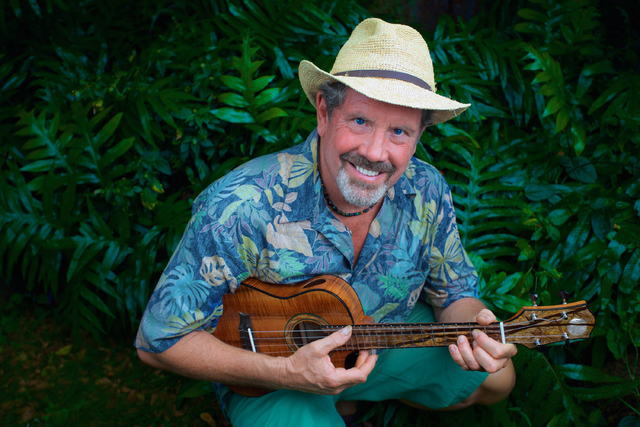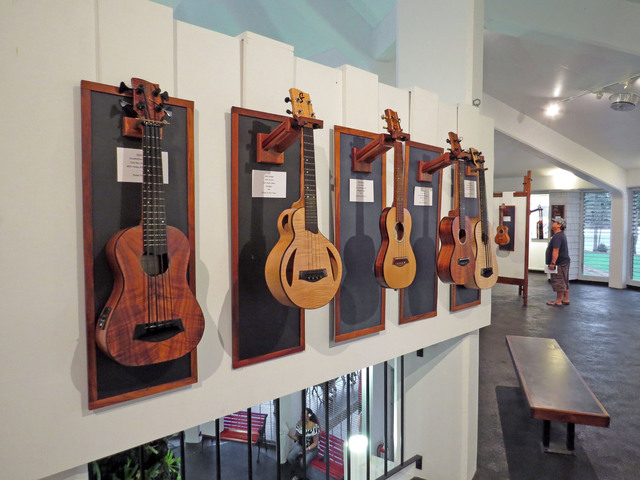Hawaii’s ukulele sound is booming nationwide. The popularity of ukulele festivals and community play groups saw the National Association of Music Merchants recently report a 54 percent jump in ukulele sales. For a month beginning Friday at Hilo’s Wailoa Arts and Cultural Center, the Big Island Ukulele Guild will exhibit instruments, share building techniques and invite all to play-a-long kanikapila jam sessions.
Hawaii’s ukulele sound is booming nationwide. The popularity of ukulele festivals and community play groups saw the National Association of Music Merchants recently report a 54 percent jump in ukulele sales. For a month beginning Friday at Hilo’s Wailoa Arts and Cultural Center, the Big Island Ukulele Guild will exhibit instruments, share building techniques and invite all to play-a-long kanikapila jam sessions.
“The Big Island Ukulele Guild show is a one-of-a-kind, once-a-year exhibit where you will be able to appreciate the native woods of Hawaii, witness the amazing talents of our instrument makers, and celebrate an icon of Hawaii lifestyle, the ukulele. It’s a great celebration of the uke,” said David Stokes, an ukulele builder and the exhibit’s coordinator.
Stokes said the annual exhibit’s opening gala at 5 p.m. Friday will feature live music, pupu and a lucky number ukulele drawing. This year’s showcase will feature an added bonus of Hawaii Wood Guild displays of exquisite Hawaii Island furniture, sculpture and bowls.
In 1982 guild member Bob Gleason, of Pegasus Guitars and Ukuleles in Volcano, began his luthier craft by selling dulcimers at West Coast folk festivals. While living in Seattle he recalls “I met a guy on street corner with a guitar case who told me about the guitar making Apprentice Shop in Tennessee. I went.”
Gleason was building guitars on the mainland when “a friend living in Naalehu called and said ‘I think you could make a living here. Hawaii has plenty of music. Every family plays.’” Convinced he moved to Ka’u. “My shop was in the back of an old Buddhist church. It’s true you can make a living here in Hawaii.”
From noon to 3 p.m. Saturday, Kona ukulele performer and instructor Alan Hale will lead an everyone-can-play-ukulele kanikipila at the center. The experienced Hale is up for the task as he conducts a weekly uke jam session on Thursdays at 9 a.m. at Keauhou Bay’s Akule Supply Co.
The uke’s accessibility is a key to its popularity, said Hale.
“It actually works well with senior groups. And senior groups everywhere on the mainland enjoy playing. A lot play old standards. It’s small, has four strings and is easy to play. In an hour you can learn the four basic chords. It is easy to carry,” he said. For do-it-yourselfers, “it doesn’t need a large space to build.”
The uke is a member of the lute instrument family and mostly features four strings. In 1879, Portuguese immigrants brought their small guitar called a “machete” to Hawaii. When it was adapted to make the ukulele, it gathered an immediate “hana hou” from both kanakas and King David Kalakaua.
Queen Lilioukalani reportedly said that ukulele’s translation means “a gift that came here.” However, folk legend says “uke” mimics uku, the word for body lice. Likely, the uke’s “jumping flea” connotation derives from describing fast-fingered players and not ukus.
Also Saturday, from noon to 3 p.m., members of the the Big Island Ukulele Guild will demonstrate ukulele construction.
“First, the mental workout. Figuring out to do something right — or how to fix something I’ve done wrong. Second, it’s a great feeling to finish an ukulele and say ‘I built this’ It taught me patience and pride of craftsmanship. And it is a joy to play an instrument built with your own hands,” said Kona’s former guild president and hobby builder, Chris Stewart, about the attraction to uke building.
In 2001, Andy Berard, a retired engineer and owner of the O Kona Ukulele store in Kailua-Kona, was meeting with a few students building ukes and started the Big Island Ukulele Guild. Gleason, one of the original members, said it was “to gather people into a collective to share ideas.”
The beauty of the Big Island Ukulele Guild, according to Gleason, is that four times a year they meet to share information on “raw materials, the environment, use the tools, how to inlay, set up frets and get the finish right. Ukulele building is different than other wood work. If someone comes and says ‘I put a finish on and this happens.’ We’ll have 30 members at a meeting and someone will have an answer.”
The present uke popularity resurgence is not its first. At the 1915 Panama Pacific International Exposition in San Francisco, there was a Hawaiian Pavilion and on center stage was an ukulele playing Royal Hawaiian Quartet. The 1920s Jazz Age saw ukuleles in vaudeville acts and silent film. In the 1950s, TV’s popular “The Arthur Godfrey Show” had Godfrey in a Hawaiian shirt teaching the instrument. Novelty sensation Tiny Tim’s song, “Tip Toe Through the Tulips,” branded the uke in the ’60s.
Today, Jake Shimabukuro’s ukulele version of George Harrison’s “While My Guitar Gently Weeps” and Brother Israel “Iz” Kamakawioole are credited with the current boom. Uke builders hit the pot-of-gold when Brother Iz’s 1993 rendition of “Somewhere over the Rainbow” became a global movie and airplay standard.
“We’re lucky in Hawaii to have beautiful wood, strong and a good variety,” said Gleason of using local woods for ukes. “Most fun to get wood in as raw form as you can get it. Takes long time to make it useable. Trees often in Hawaii are harvested from windfall or land clearing or the tree died. My wife and I do it together, Hawaiian woods right from the chainsaw. Cut whatever you can handle, what I can lift. Then I cut it 2 inches thick and it’s air dried, stacked with stickers between the wood so there’s airflow. Then after two years or so, I process saw it into thin slices 3/16-inch or so. Again, I sticker for airflow. I have a lot of wood. Aging for instruments the longer the better at least 4 to 5 years old.”
Jay Warner is a veteran Hawaii Island wood harvester who supplies guild members like Woodley White and David Gomes, Oahu’s iconic Kamaka Ukuleles and high-end mainland guitar makers like Martin, Taylor and Santa Cruz.
Warner says for him “koa is the main thing. Most comes from dead or damaged trees.” The most desired koa is curly koa, which he says “is genetic like having curly hair. One of your kids might have curly if a grandparent did.”
Selling to instrument makers for Warner is a specialized negotiation because he says they “need uniform wood to bend. The instrument niche, it’s big and they pay top dollar. Higher money than anybody but it’s less than 20 percent of my sales.”
“They are very picky. One out of five logs is what they want. They want the pick of the mill. Disruptive as a sawyer. Can spend a whole day with them. Making a lot of guitar with very little wood. Not perfect not worth it. Most people don’t have a clue how much it takes. I usually start the conversation with they’re way too picky and then we get along just fine.”
“With select koa selling for a much a $30 thousand for a log,” Warner finishes. “The hobby instrument builder turns to buying $300 wood sets.”
Gleason sells these wood sets and parts to supplement income and says for the last two years he has been building more using local woods exclusively.
“For the body koa, mango, peasant wood all work fine. Neck wood is usually South American mahogany, but Hawaiian toon is a good replacement. Fret wood sees peasant wood and keawe,” he said. “You can make the entire body out of local woods.”
Oct. 17th’s kanipila will be a treat for uke aficionados led by Andy Andrews. Andrews co-founded the renown Ukulele Club of Santa Cruz, featured in the film “The Mighty Uke.” He also teaches uke at Kua O Ka La Charter School and started the Puna Ukulele &Kanikapila Association. The kanikapila will be from from 12 p.m.to 3 p.m.
”He’s very well known, a famous teacher and has several song books that everyone uses around the country,” said Stokes, the exhibit’s coordinator.
Stokes says the ukulele exhibit is the Wailoa Art and Cultural Center’s best-attended show. During the ukulele month’s festivities, the public will vote for the People’s Choice Award ukulele. For more information about the Big Island Ukulele Guild’s exhibit contact Dave Stokes at 989-8890 or visit www.BigIslandUkuleleGuild.org. The Wailoa Art and Cultural Center can be reached at 933-0416. The uke show is open 9 a.m. to 4:30 p.m. Monday through Friday and will close Oct. 29.


